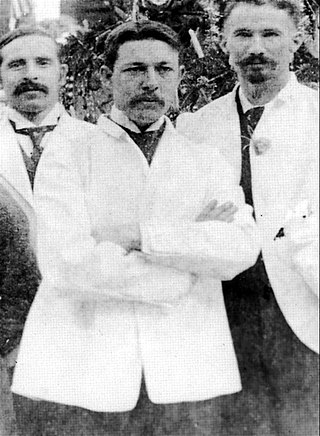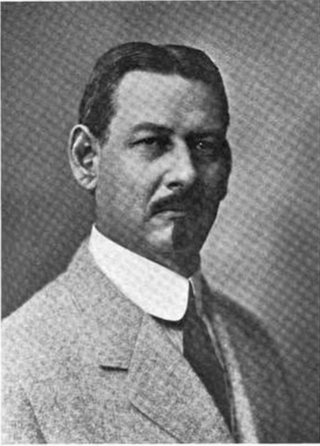
Orthopedic surgery or orthopedics is the branch of surgery concerned with conditions involving the musculoskeletal system. Orthopedic surgeons use both surgical and nonsurgical means to treat musculoskeletal trauma, spine diseases, sports injuries, degenerative diseases, infections, tumors, and congenital disorders.

Hospital for Special Surgery (HSS) is a hospital in New York City that specializes in orthopedic surgery and the treatment of rheumatologic conditions.

William Bradley Coley was an American bone surgeon and cancer researcher best known for his early contributions to the study of cancer immunotherapy, specifically causing infection as a way to fight cancer, a practice used as far back as 1550 BC. His work was not proven effective in his lifetime, and today Coley's toxins are known to be both ineffective and potentially harmful. Coley is nevertheless recognized as the Father of Cancer Immunotherapy for his contributions to the science.

Edville Gerhardt Abbott was an American orthopedic surgeon, orthotist and inventor.

Spine is a biweekly peer-reviewed medical journal covering research in the field of orthopaedics, especially concerning the spine. It was established in 1976 and is published by Lippincott Williams & Wilkins. The current editor-in-chief is Andrew J. Schoenfeld, M.D.. Spine is considered the leading orthopaedic journal covering cutting-edge spine research. Spine is available in print and online. Spine is considered the most cited journal in orthopaedics.

Spinal disease refers to a condition impairing the backbone. These include various diseases of the back or spine ("dorso-"), such as kyphosis. Dorsalgia refers to back pain. Some other spinal diseases include spinal muscular atrophy, ankylosing spondylitis, lumbar spinal stenosis, spina bifida, spinal tumors, osteoporosis and cauda equina syndrome.
David Marsh Bosworth was an American orthopedic surgeon and medical educator. He is remembered for describing the Bosworth fracture.
John Nevil Insall (1930–2000) was a pioneering English orthopaedic surgeon who contributed extensively to the advancement of orthopedic surgery and total knee replacement surgery. Insall designed four models of widely used systems, including the ground breaking Total Condylar Knee in 1974.

Paul Randall Harrington was an American orthopaedic surgeon. He is best known as the designer of the Harrington Rod, the first device for the straightening and immobilization of the spine inside the body. It entered common use in the early 1960s and remained the gold standard for scoliosis surgery until the late 1990s. During this period over one million people benefited from Harrington's procedure.

The University Orthopaedic Center is the only full-service specialty center of its kind in the Intermountain West, including services in joint reconstruction, sports medicine, pediatric orthopaedics, spinal disorders, hand, foot and ankle, trauma, musculoskeletal oncology, shoulder and elbow, and physical therapy.
Sean E. McCance is an American orthopedic surgeon and Co-Director of Spine Surgery in the Leni and Peter W. May Department of Orthopaedics at the Mount Sinai Medical Center in New York City. Additionally, he is an Associate Clinical Professor of Orthopaedics at the Mount Sinai School of Medicine and Attending Spine Physician at Lenox Hill Hospital.
Andrew C. Hecht is an American orthopaedic surgeon and a nationally recognized leader in surgery on the spine.
John Robert Cobb (1903–1967), was an American orthopedic surgeon who invented the eponymous Cobb angle, the preferred method of measuring the degree of scoliosis and post-traumatic kyphosis.
John H. Healey is an American cancer surgeon, researcher, and expert in the surgical treatment of benign and malignant bone tumors and other musculoskeletal cancers. He serves as Chair of the Orthopaedic Service and Stephen P. McDermott Chair in Surgery at Memorial Sloan-Kettering Cancer Center (MSKCC), as well as Professor of Surgery at Weill Cornell Medical College, in New York, NY.
William Edward Gallie was a Canadian medical educator and orthopedic surgeon.
Oheneba Boachie-Adjei is a Ghanaian orthopaedic surgeon. He specializes in spinal reconstruction and the treatment of kyphosis and scoliosis. He is professor of orthopaedic surgery at Weill Cornell Medical College in New York City, in the United States, and is an attending orthopaedic surgeon at Hospital for Special Surgery, at New York-Presbyterian Hospital and at Memorial Sloan-Kettering Cancer Center, all in New York City. From 1972 to 1976 he studied at Brooklyn College, Brooklyn, New York, in the United States, where he completed a BS degree summa cum laude. He then studied medicine at the Columbia University College of Physicians and Surgeons.
Joseph D. Zuckerman is an American orthopedic surgeon specializing in shoulder, hip and knee replacement surgery.
Yash Gulati is an Indian orthopedic surgeon and the senior consultant orthopaedic surgeon at Indraprastha Apollo Hospitals, New Delhi. He specializes in joint replacement and spine surgeries and is a visiting consultant at RAK Hospital, Ras al-Khaimah. He is the youngest orthopedic surgeon to win the civilian honour of the Padma Shri.
Augustus A. White III is an American surgeon who is the Ellen and Melvin Gordon Distinguished Professor of Medical Education and Professor of Orthopedic Surgery at Harvard Medical School and a former Orthopaedic Surgeon-in-Chief at Beth Israel Hospital, Boston, Massachusetts. White was the first African American medical student at Stanford, surgical resident at Yale University, professor of medicine at Yale, and department head at a Harvard-affiliated hospital.
Philip Duncan Wilson Jr. (1920–2016) was an orthopedic surgeon who brought total hip replacement surgery to the Hospital for Special Surgery in 1967. He started at the Hospital for Special Surgery in 1948, and served as the Surgeon-in-Chief from 1972 to 1989. He served as the President of the American Academy of Orthopaedic Surgeons in 1972.








